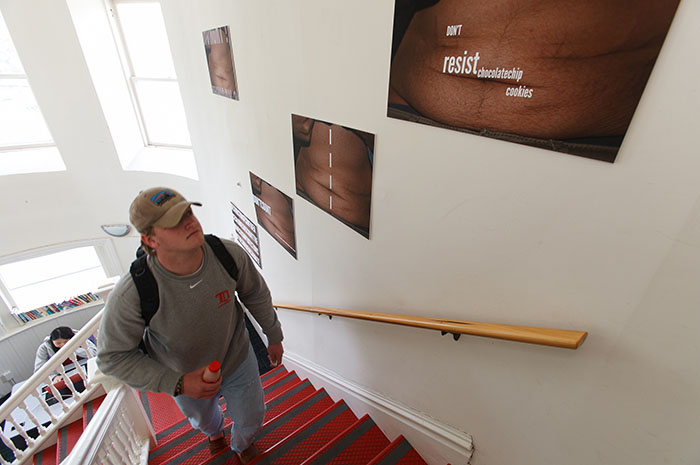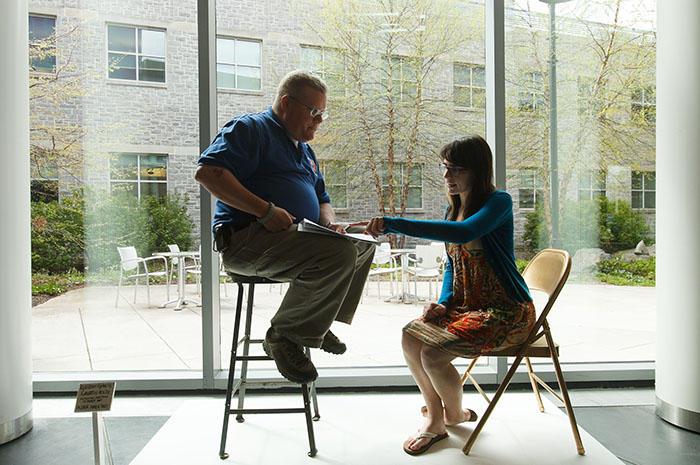‘Please Touch!’

Impermanent artwork by Fabian Hernanedez '15 lines the Quarry stairway. The works were created by students and installed in high-traffic areas on campus during the final weeks of the spring semester. Photo by Carl Socolow '77.
Art students create ephemeral works with enduring appeal
by MaryAlice Bitts-Jackson
As the semester wound down, many of Associate Professor of Studio Art Anthony Cervino’s students geared up, collectively installing 14 original artworks across campus during the past two weeks. Placed in high-traffic areas, the art provides opportunities for interaction and a respite from the stress of final papers and exams.
Seven are text-based works by students in Cervino’s Post Studio Practices class and can be viewed in The Quarry, Union Station, The Underground, Biblio Café and Dining Hall. The rest were created by members of Cervino’s spring Sustainable Public Art class. All were designed to deepen social sustainability on campus by encouraging passersby to actively engage with one another through art.
“It’s about generating positive social practices and strengthening our sense of community,” said Lauren Holtz ’15, a double major in neuroscience and art & art history and a member of the public-art class.
Kitchens, klatches and kindness
During the last week of the semester, Holtz and fellow public-art students Ilana Unger ’15 (environmental studies and art & art history) and Carley Zarzeka ’15 (art & art history) installed major art pieces across campus that invited passersby to action.
Holtz’s chair installations, displayed in the Rector Science Complex Atrium and on Weiss Plaza, highlight interdependence within communities. Those who sit on a seesaw-like structure retain personal space, but because their chairs are connected, they must cooperate, whereas a tall stool facing a standard folding chair creates or exaggerates social disconnect, or a need to bridge communication gaps.
Unger installed a “Kindness Well” on the Holland Union Building’s patio and filled it with written directives like “Write a sincere thank-you note” and “Wish someone good luck on finals.” Passersby were asked to dip into the well and do as requested. “We all get so wrapped up inside ourselves in college, especially at this time of year, because we’re so busy, and it can be easy to lose sight of others,” she said. “The point is not to tell people what to do but to get them thinking about what they can do to replenish acts of kindness on campus.”

An art installation by Lauren Holtz '15 challenges participants to overcome social inequities, or perceived social inequities, through communication. Photo by Carl Socolow '77.
Zarzeka constructed a kitchen counter and placed it on Weiss Plaza. “You read in magazines that the kitchen is the ‘heart of the home,’ because it’s where a lot of conversations take place,” she explained, adding that she hoped to encourage the kind of in-depth discussions she has had in the kitchen with her stepmother.
Drawing them in
While Zarzeka, Unger and Holtz created art that could be experienced without artist supervision and participation, Dana Angotta ’14 (art & art history), Lizzie Wilford ’16 (art & art history) and Stephanie Read ’16 (English) brought participants into real-time art-making processes. Their works were displayed for one day only—the Sunday before finals.
“I wanted to concentrate on the fact that we’re all a part of the Dickinson family and the human family,” said Angotta, who made carnival cutouts—photo boards of faceless people that create photo ops at festivals and fairs. Each board depicted a family configuration (nuclear, single-parent, childless, etc), and passersby were invited to pose for a shot; Angotta would later digitally add backgrounds to the images, placing the subjects in different home environments.
Read sought more intimate collaborations when she created an easel and a device that connected two participants’ hands. “That way, two strangers will be able to create the same painting together, and the painting will show the precise moments when they become part of each other’s lives,” she said.
Wilford posed a series of questions to passersby that ranged from the innocuous (“What’s your middle name?”) to the intimate (“What are you afraid of?”). Participants got to know one another better with every answered question, and all who answered were invited to throw a dart at a Masonite board, onto which Wilford had tacked a mass of paint-filled balloons. Whenever a balloon popped, paint splattered onto the Masonite, contributing to a communal work of art.
As Holtz points out, each of the artists had to address challenges that are unique to public art—the work must be weatherproof, site-appropriate and kid-friendly, for example—but they also reaped the rewards of immediate feedback. That the works drew people together added another level of satisfaction, she said.
“It’s definitely different to create a piece that people will be sitting on and interacting with, and it forces you to think about the process in new ways,” Holtz said. “In a museum, there are signs that say, ‘Don’t touch,’ and here, we’re saying, ‘Please touch. Please interact!’ ”
Learn more
Published May 7, 2014